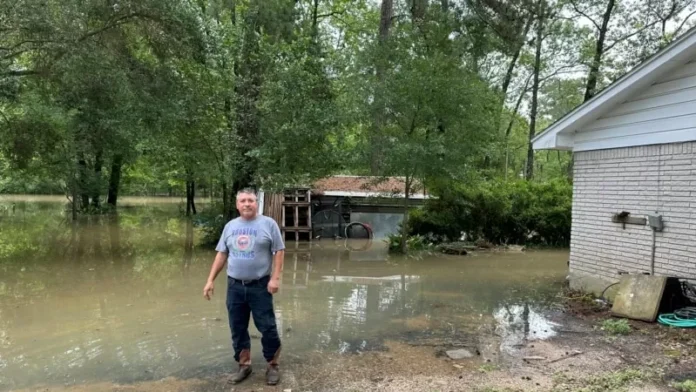Houston, Texas has been hit hard by heavy rains, resulting in high waters that have flooded neighborhoods and caused chaos for residents. The situation is dire, with hundreds of people being rescued from their homes, rooftops, and roads that are now submerged in murky water.
The National Weather Service has issued a flood watch that will remain in effect until Sunday afternoon, as more rainfall is expected to hit the already soaked region. This could bring an additional 1 to 3 inches of water, further exacerbating the flooding and increasing the likelihood of major damage.
The storms that hit on Friday were fierce, causing numerous high-water rescues, including some from the rooftops of flooded homes. As a result, officials are urgently instructing residents in low-lying areas to evacuate, warning that the worst is yet to come.
Harris County Judge Lina Hidalgo, the top elected official in the nation’s third-largest county, has described the predicted surge of water as “catastrophic.” Schools in the affected areas have canceled classes, and roads have become jammed as authorities closed highways that were taking on water.
For weeks, Texas and parts of Louisiana have been experiencing heavy rains, causing reservoirs to fill up and the ground to become saturated. This has resulted in floodwaters partially submerging cars and roads across southeastern Texas, north of Houston. In some areas, the water has even reached the roofs of homes.
According to the National Weather Service, more than 21 inches of rain fell in Liberty County near the city of Splendora in just five days. In the rural community of Shepherd, residents Gilroy Fernandes and his spouse were given only an hour to evacuate their home, which is located on stilts near the Trinity River. They were relieved when the water began to recede on Thursday, but their relief was short-lived. Overnight, authorities released more water from the dam at Livingston, causing the river to rise by almost five or six feet. This caught many residents off guard, and some even got stuck in traffic while trying to evacuate.
The Harris County Joint Information Center has reported that 196 people and 108 animals have been rescued by emergency response agencies in Harris County alone. In neighboring Montgomery County, Judge Mark Keough estimates that there have been hundreds of high-water rescues from homes, houses, and vehicles.
Polk County, located about 100 miles northeast of Houston, has also been heavily affected by the floods. Officials have conducted over 100 water rescues in the past few days, with homes below Lake Livingston Dam and along the Trinity River being the most affected. However, it will be some time before a full damage assessment can be done, as the water levels need to subside first.
Thankfully, there have been no reported deaths or injuries in Houston so far. The city, with a population of over 2 million people, is no stranger to floods and has long experience in dealing with devastating weather. In 2017, Hurricane Harvey caused historic rainfall, flooding thousands of homes and resulting in over 60,000 rescues by government personnel across Harris County.
One area of particular concern is along the San Jacinto River in the northeastern part of Harris County. The river is expected to continue rising as more rain falls and officials release extra water from an already full reservoir. In response, Judge Hidalgo issued a mandatory evacuation order for those living along portions of the river on Thursday.
While most of Houston’s city limits have not been heavily affected by the weather, the northeastern neighborhood of Kingwood has been hit hard. Officials estimate that the area has received four months’ worth of rain in just one week. Mayor John Whitmire has warned that the rising floodwaters from the San Jacinto River are expected to affect Kingwood late Friday and Saturday.
Shelters have been opened across the region, with nine being run by the American Red Cross. The National Weather Service has reported that the river was nearly 74 feet on Saturday morning, after reaching a peak of nearly 77.7 feet. However, the forecast predicts that the river will fall to near the flood stage of 57.7 feet by Thursday.
The greater Houston area covers about 10,000 square miles, which is slightly bigger than the state of New Jersey. It is crisscrossed by about 1,700 miles of channels, creeks, and bayous that drain into the Gulf of Mexico, located about 50 miles southeast from

